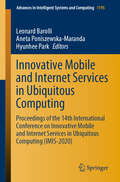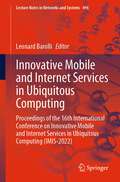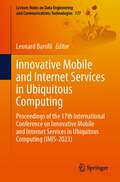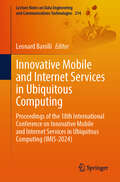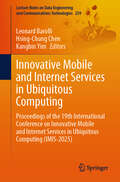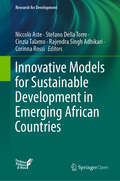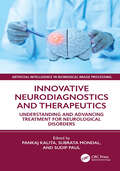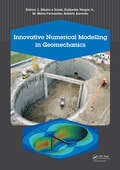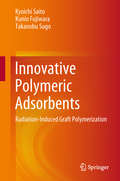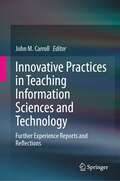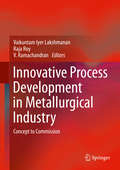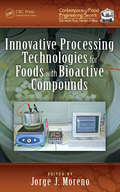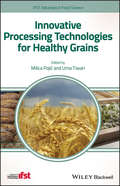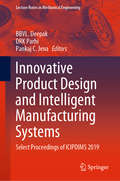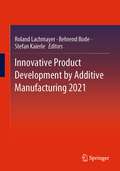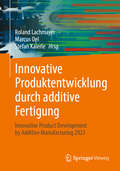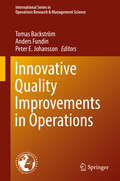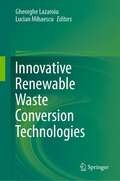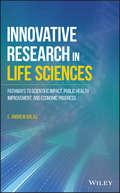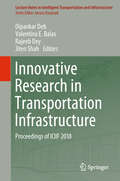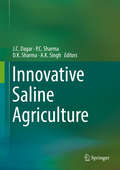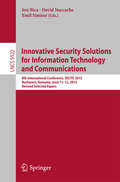- Table View
- List View
Innovative Mobile and Internet Services in Ubiquitous Computing: Proceedings of the 14th International Conference on Innovative Mobile and Internet Services in Ubiquitous Computing (IMIS-2020) (Advances in Intelligent Systems and Computing #1195)
by Hyunhee Park Leonard Barolli Aneta Poniszewska-MarandaThis book presents the latest research findings, methods and development techniques, challenges and solutions concerning UPC from both theoretical and practical perspectives, with an emphasis on innovative, mobile and Internet services. With the proliferation of wireless technologies and electronic devices, there is a rapidly growing interest in Ubiquitous and Pervasive Computing (UPC), which makes it possible to create a human-oriented computing environment in which computer chips are embedded in everyday objects and interact with the physical world. Through UPC, people can go online even while moving around, thus enjoying nearly permanent access to their preferred services. Though it has the potential to revolutionize our lives, UPC also poses a number of new research challenges.
Innovative Mobile and Internet Services in Ubiquitous Computing: Proceedings of the 16th International Conference on Innovative Mobile and Internet Services in Ubiquitous Computing (IMIS-2022) (Lecture Notes in Networks and Systems #496)
by Leonard BarolliThe aim of the book “Innovative Mobile and Internet Services in Ubiquitous Computing” is to provide latest research findings, methods and development techniques, challenges and solutions from both theoretical and practical perspectives related to UPC with an emphasis on innovative, mobile and internet services. With the proliferation of wireless technologies and electronic devices, there is a fast-growing interest in Ubiquitous and Pervasive Computing (UPC). The UPC enables to create a human-oriented computing environment where computer chips are embedded in everyday objects and interact with physical world. Through UPC, people can get online even while moving around, thus having almost permanent access to their preferred services. With a great potential to revolutionize our lives, UPC also poses new research challenges.
Innovative Mobile and Internet Services in Ubiquitous Computing: Proceedings of the 17th International Conference on Innovative Mobile and Internet Services in Ubiquitous Computing (IMIS-2023) (Lecture Notes on Data Engineering and Communications Technologies #177)
by Leonard BarolliThis book provides latest research findings, methods and development techniques, challenges and solutions from both theoretical and practical perspectives related to Ubiquitous and Pervasive Computing (UPC) with an emphasis on innovative, mobile and internet services. With the proliferation of wireless technologies and electronic devices, there is a fast-growing interest in UPC, which enables to create a human-oriented computing environment where computer chips are embedded in everyday objects and interact with the physical world. Through UPC, people can be online even while moving around, thus having almost permanent access to their preferred services. With a great potential to revolutionize our lives, UPC also poses new research challenges.
Innovative Mobile and Internet Services in Ubiquitous Computing: Proceedings of the 18th International Conference on Innovative Mobile and Internet Services in Ubiquitous Computing (IMIS-2024) (Lecture Notes on Data Engineering and Communications Technologies #214)
by Leonard BarolliWith the proliferation of wireless technologies and electronic devices, there is a fast growing interest in Ubiquitous and Pervasive Computing (UPC). The UPC enables to create a human-oriented computing environment where computer chips are embedded in everyday objects and interact with physical world. Through UPC, people can get online even while moving around, thus having almost permanent access to their preferred services. With a great potential to revolutionize our lives, UPC also poses new research challenges. The aim of the book is to provide latest research findings, methods and development techniques, challenges, and solutions from both theoretical and practical perspectives related to UPC with an emphasis on innovative, mobile and Internet services.
Innovative Mobile and Internet Services in Ubiquitous Computing: Proceedings of the 19th International Conference on Innovative Mobile and Internet Services in Ubiquitous Computing (IMIS-2025) (Lecture Notes on Data Engineering and Communications Technologies #259)
by Leonard Barolli Hsing-Chung Chen Kangbin YimThis book provides latest research findings, methods and development techniques, challenges and solutions from both theoretical and practical perspectives related to Ubiquitous and Pervasive Computing (UPC) with an emphasis on innovative, mobile and internet services.With the proliferation of wireless technologies and electronic devices, there is a fast growing interest in UPC, which enables the human-oriented computing environment where computer chips are embedded in everyday objects and interact with physical world. Through UPC, people can get online even while moving around, thus having almost permanent access to their preferred services. With a great potential to revolutionize our lives, UPC also poses new research challenges.
Innovative Models for Sustainable Development in Emerging African Countries (Research for Development)
by Corinna Rossi Cinzia Talamo Stefano Della Torre Niccolò Aste Rajendra Singh AdhikariThis open access book explores key issues and presents recent case studies in areas of importance for the transition to a circular model of development in emerging African countries that will minimize resource consumption and waste production. The topics covered include the development of sustainable housing models, energy and environmental issues in building design and technical systems, recycling for a sustainable future, models for humanitarian emergencies, and low-cost and web-based digital tools with applications in architecture and archaeology. The aim is to contribute to a necessary paradigm shift with respect to urban planning and usage of territories, moving from a linear urban metabolism based on the “take, make, dispose” approach to a circular metabolism. Such a change requires a focus on the relationship between the architectural, urban, and physical aspects of new developments, climate, and energy demand, as well as the identification and integration of strategies and infrastructures to achieve a high level of efficiency and self-sufficiency. The book will appeal to all with an interest in sustainable development in the African context.
Innovative Neurodiagnostics and Therapeutics: Understanding and Advancing Treatment for Neurological Disorders (Artificial Intelligence in Biomedical Image Processing)
by Subrata Mondal Sudip Paul Pankaj KalitaThis book presents the latest technological advancements in the understanding and diagnosis of neurological disorders. The chapters provide the complexities of diagnosis, understanding pathogenesis, and unveiling the latest therapeutic strategies against neurodegenerative disorders. Innovative Neurodiagnostics and Therapeutics: Understanding and Advancing Treatment for Neurological Disorders also explores the transformative role of optogenetics, nanoarchitectonics, machine learning, and artificial intelligence in neurodiagnosis. Metal organic frameworks are explored for their prospective applications in neuroscience. The book continues to unfold with a focus on robotic advancements in neurotherapeutics, offering comprehensive insights into the cutting edge of neurotherapeutic interventions. The complex interplay between neurodiagnostics and psychodiagnostics is explored in the context of substance use disorders. The book concludes by examining the potential of aquaporin as a therapeutic target in neurological disorders. As such, this book is an invaluable source for neuroscientists, neurologists, and computational biologists.
Innovative Numerical Modelling in Geomechanics
by L. Ribeiro e Sousa Eurípedes Vargas Manuel de Matos Fernandes Roberto AzevedoSince the 1990s five books onApplications of Computational Mechanics in Geotechnical Engineering have been published. Innovative Numerical Modelling in Geomechanics is the 6th and final book in this series, and contains papers written by leading experts on computational mechanics. The book treats highly relevant topics in the field of geotechnic
Innovative Pedagogical Practices for Higher Education 4.0: Solutions and Demands of the Modern Classroom
by Muhammad Mujtaba Asad Fahad Sherwani Razali Bin Hassan Prathamesh Padmakar ChuriInnovative and creative teaching methods tailored to meet the demands of the current era of Industrial Revolution 4.0 are becoming increasingly prevalent in higher education institutions. Educators must cultivate and implement these strategies in their classrooms to incorporate the essential skills of Education 4.0 and digitalization in education. This book aims to explore and showcase various aspects of innovative pedagogies for Higher Education 4.0, drawing from best practices worldwide to provide a comprehensive understanding of this evolving field.Innovative Pedagogical Practices for Higher Education 4.0 highlights the cutting‑edge technologies essential for Education 4.0 and equips educators with the skills required for 21st‑century teaching. Through international case studies, this book explores the integration of educational technology, illuminating the obstacles encountered by educational institutions aiming to embrace Education 4.0 in higher education settings. Furthermore, it presents inventive tools and strategies for harnessing technology in teaching, offering a new outlook on innovative pedagogies.This book meets the need for solutions that tackle the challenges of Education 4.0 and demonstrates how these challenges can be overcome through innovative pedagogies for student learning in higher education institutions. It is a valuable resource for educators, specialists, academic institutions, and policymakers seeking practical solutions in the ever‑evolving landscape of education.
Innovative Polymeric Adsorbents: Radiation-induced Graft Polymerization
by Kyoichi Saito Kunio Fujiwara Takanobu SugoThis book presents the reader with a story-based narrative of discovery and development of radiation-induced graft polymerization. The report presented here accomplishes this by relating the inspiring account of research and development based on long-term collaboration among a professor, an engineer, and an entrepreneur. Their goal, ultimately successful, was to come up with a method for grafting functional polymer chains onto existing trunk polymers. The desired outcome was to produce feasible forms for practical use as adsorbents such as porous hollow-fiber membranes, porous sheets, nonwoven fabrics, and fibers. Adsorbents that specifically and efficiently bind to target ions and molecules are essential for capturing uranium species in seawater and antibody drugs in biological fluids and for removing metal ions from ultrapure water and radioactive cesium ions from contaminated water.This unique volume, with its clearly written text and many illustrative figures and diagrams, demonstrates the advantages of the high-adsorption capacity and rate and the easy handling of new polymeric adsorbents over conventional adsorbents. The dynamic behavior of graft chains as described here is certain to appeal especially to chemists, physicists, and material scientists as well as to other readers with an interest in this valuable subject.
Innovative Practices in Teaching Information Sciences and Technology: Further Experience Reports and Reflections
by John M. CarrollInformation Sciences and Technology (IST) is a rapidly developing, interdisciplinary area of university research and educational programs. It encompasses artificial intelligence, data science, human-computer interaction, security and privacy, and social informatics. In both research and teaching, IST ambitiously addresses interdisciplinary synergies across this broad foundation. Many articles and books discuss innovative research practices in IST, but innovations in teaching practices are less systematically shared. Although new programs and new faculty join IST each year, they basically have only their own imaginations to draw upon in developing effective and appropriate innovative teaching practices. This book presents essays by experienced faculty instructors in IST describing insights that emerged from teaching and learning classroom practice, and that have been validated through classroom experience. The book is intended to help develop and strengthen a community of practice for innovative teaching in IST.
Innovative Process Development in Metallurgical Industry
by Vaikuntam Iyer Lakshmanan Raja Roy V. RamachandranThis book describes the phases for innovative metallurgical process development, from concept to commercialization. Key features of the book include: * Need for process innovation * Selection and optimization of process steps * Determination of the commercial feasibility of a process including engineering and equipment selection * Determination of the environmental footprint of a process * Case-study examples of innovative process development
Innovative Processing Technologies for Foods with Bioactive Compounds (Contemporary Food Engineering #38)
by Jorge J. MorenoNatural foods, like fruits and vegetables, represent the simplest form of functional foods and provide excellent sources of functional compounds. Maximizing opportunities to make use of and incorporate these compounds requires special processing. Fortunately, technologies available to produce food with enhanced active compounds have advanced significantly over the last few years. This book covers the fundamentals as well as the innovations made during the last few years on the emerging technologies used in the development of food with bioactive compounds.
Innovative Processing Technologies for Healthy Grains (IFST Advances in Food Science)
by Milica Pojić Uma TiwariInterest in cereals and other healthy grains has increased considerably in recent years, driving the cereal processing industry to develop new processing technologies that meet consumer demands for sustainable and nutritious cereal products. Innovative Processing Technologies for Healthy Grains is the first dedicated reference to focus on advances in cereal processing and bio-refinery of cereals and pseudocereals, presenting a broad overview of all aspects of both conventional and novel processing techniques and methods. Featuring contributions from leading researchers and academics, this unique volume examines the selection and characteristics of raw ingredients, new and emerging processing technologies, novel cereal-based products, and global trends in cereal and pseudocereal use, processing and consumption. The text offers balanced coverage of advances in both the development and processing of cereal and pseudocereal products, exploring topics including gluten-free products, cereal-based animal feed, health and wellness trends in healthy grain consumption, bioaccessibility and bioavailability of nutritional compounds, gluten-free products, and the environmental impact of processed healthy grains. This timely and comprehensive volume: Focuses on innovative cereal processing and bio-refinery of cereals and pseudocereals Provides informed perspectives on the current global trends in cereal and pseudocereal use, processing and consumption Describes the characteristics of healthy grains and their production, nutritional value, and utilization Explains the origin, production, processing, and functional ingredients of pseudocereals Reviews healthy grain products such as cereal-based beverages, fortified grain-based products, and cereal-based products with bioactive benefits Part of Wiley's IFST Advances in Food Science series Innovative Processing Technologies for Healthy Grains is an essential resource for food scientists, technologists, researchers, and other professionals working in the grain indus
Innovative Product Design and Intelligent Manufacturing Systems: Select Proceedings of ICIPDIMS 2019 (Lecture Notes in Mechanical Engineering)
by Bbvl. Deepak Drk Parhi Pankaj C. JenaThis book gathers selected research articles from the International Conference on Innovative Product Design and Intelligent Manufacturing System (ICIPDIMS 2019), held at the National Institute of Technology, Rourkela, India. The book discusses latest methods and advanced tools from different areas of design and manufacturing technology. The main topics covered include design methodologies, industry 4.0, smart manufacturing, and advances in robotics among others. The contents of this book are useful for academics as well as professionals working in industrial design, mechatronics, robotics, and automation.
Innovative Product Development by Additive Manufacturing 2021
by Roland Lachmayer Stefan Kaierle Behrend BodeThe book consists of a collection of papers from a corresponding conference regarding additive manufacturing. The yearly conference used to be held in German under the title: “Konstruktion für die Additive Fertigung.” The topics are: • Design and optimization • Simulation, validation and quality assurance • Specifications, potentials and solutions
Innovative Product Development by Additive Manufacturing 2022
by Roland Lachmayer Stefan Kaierle Behrend BodeThe book consists of a collection of papers from a corresponding conference regarding additive manufacturing. The yearly conference used to be held in German under the title "Konstruktion für die Additive Fertigung" and is held in English since last year. The topics are Specifications, potentials, and solutions Contributions to specifications on components and processes and methods for assessing the suitability of components and the application of additive manufacturing and finding solutions for concepts and design Design and optimization Contributions to the development and design of components, their design to ensure functional requirements and manufacturability, and methods and tools for optimization components Simulation, validation, and quality assurance Contributions to approaches for the computer-aided and physical validation of components, the testing of components and material, and measures to ensure quality aspects Process chain and business modelsContributions to their integration of additive manufacturing processes into existing processes and measures to increase value creation and the creation of new business models.
Innovative Produktentwicklung durch additive Fertigung: Innovative Product Development by Additive Manufacturing 2023
by Roland Lachmayer Stefan Kaierle Marcus OelAdditive Manufacturing processes are already being used successfully in wide-ranging areas such as the automotive industry, mechanical and plant engineering and medical technology. Due to high flexibility, targeted variation of the machine parameters and the often contactless production, there is a considerable added value compared to conventional processes. A decisive factor in the process chain of additive manufacturing is the design. Components can be newly or differently designed and optimized, for example, with regard to their topology or the integration of functions and effects. For an evaluation of suitability, potentials and requirements must be specified, geometries must be designed and components must be simulated and validated. In addition, a close link between internal company processes, business models and the design are necessary.
Innovative Produktentwicklung durch additive Fertigung: Innovative Product Development by Additive Manufacturing 2024
by Roland Lachmayer Stefan Kaierle Marcus OelDie additive Fertigung wird bereits in einer Vielzahl an Bereichen, wie der Automobilindustrie, dem Maschinen- und Anlagenbau und der Medizintechnik erfolgreich eingesetzt. Dabei bieten die hohe Flexibilität, die Ressourceneffizienz und die Möglichkeit zur Umsetzung komplexer Geometrien einen entscheidenden Vorteil gegenüber konventionellen Fertigungsverfahren. Fortschritte in der Technologie treiben das Wachstum der Branche voran und eröffnen neue Potenziale in der Serienfertigung. Gleichzeitig ergeben sich Herausforderungen in der Qualitätssicherung und der Einbindung additiv gefertigter Komponenten in bestehende Prozesse. Um die Möglichkeiten der additiven Fertigung optimal auszunutzen, ist eine enge Verknüpfung innerhalb der Phasen der Produktentwicklung notwendig.
Innovative Quality Improvements in Operations
by Tomas Backström Anders Fundin Peter E. JohanssonThis book examines current and emerging challenges in manufacturing related to the ideal of developing production processes with variability and agility on one level of the system, combined with structures ensuring stability and robustness on another level; close to what by other scholars has been discussed in terms of continuous innovation. However, this ideal has proven to be difficult to achieve in practice, and there is a need for enhanced and more sophisticated theoretical models dealing with the complexity surrounding organizational conditions to foster incremental as well as radical change in production systems, and, at the same time to ensure stability over time. As a theoretical frame of reference, a perspective on change where conflicting demands and conflicting activities, e. g. , exploration and exploitation, are seen as intertwined and interdependent, is used throughout the book. The ideal from this perspective is to make use of such conflicting forces and to develop the change dynamics by keeping them in the same social system, not to structurally separate them in different departments or different initiatives. The main purpose of the book is to address an increased need for quality improvement through innovation and disruptive change in production. Traditional theories and managerial models of production systems are developed with a focus on stability and improvement. There is a need for enhanced models to reach an ability to develop new future production systems. The goal of the book is to provide nuances and new perspectives giving more realistic models of the production system to be able to increase the change potentiality of the organization and thus the long-term competiveness. Learning and organizational perspectives are in focus as enablers to increase the understanding of a production system as such. Long-term competitiveness through adaptability and the potential for radical improvement is of importance throughout the book. The use of dualities and the concept of ambidextrous organizations as a frame of understanding is the innovative strength for this area.
Innovative Renewable Waste Conversion Technologies
by Gheorghe Lazaroiu Lucian MihaescuThis book investigates innovative solutions to increase the share of renewable engery in the global power mix, with a particular focus on improved and sustainable biomass conversion technologies. To this end, the book deals with an analysis of the generation mix of renewable energies (including biofuels, renewable waste and biogas) in the overall power balance of several countries. In addition, the possibilities of using bioenergy resources in the context of power generation are thoroughly analyzed. As one of the most important ways of converting biomass into energy, the combustion process is analyzed in detail, highlighting the vast potential for the use of innovative biofuels. In this context, a detailed classification of existing biofuels is established, reflecting the relationship between their energy properties and their potential use in industrial facilities. Additionally, the most efficient combustion technologies for the respective applications are discussed. Furthermore, the authors emphasize that the management of renewable waste, both from industry (tannery waste and oils from transport) and agriculture, requires an economic and environmental friendly approach. The challenges of burning various renewable waste fuels and upgrading industrial facilities are discussed, and the ideas and technologies presented in this book contribute to the UN Sustainable Development Goal (SDG) for "Affordable and Clean Energy". The book is a useful resource for professionals dealing with current and upcoming activities related to renewable energy combustion, and a good starting point for young researchers.
Innovative Research in Life Sciences: Pathways to Scientific Impact, Public Health Improvement, and Economic Progress
by E. Andrew Balas“I thoroughly enjoyed reading this book as it has taken me on a journey through time, across the globe and through multiple disciplines. Indeed, we need to be thinking about these concepts and applying them every day to do our jobs better.” Farah Magrabi, Macquarie University, Australia “The reader will find intriguing not only the title but also the content of the book. I’m also pleased that public health, and even more specifically epidemiology has an important place in this ambitious discussion.” Elena Andresen, Oregon Health & Science University, USA “This book is very well written and addresses an important topic. It presents many reasons why basic scientists/researchers should establish collaborations and access information outside traditional means and not limit thinking but rather expand such and perhaps develop more innovative and translational research ventures that will advance science and not move it laterally.” Gerald Pepe, Eastern Virginia Medical School, USA “This book gathers logically and presents interestingly (with many examples) the qualities and attitudes a researcher must possess in order to become successful. On the long run, the deep and carefully reexamined research will be the one that lasts.” Zoltán Néda, Babeş-Bolyai University, Romania “I really liked the five pillars delineating the components of humanism in research. This book has made a major contribution to the research ethics literature.” David Fleming, University of Missouri, USA A comprehensive review of the research phase of life sciences from design to discovery with suggestions to improve innovation This vital resource explores the creative processes leading to biomedical innovation, identifies the obstacles and best practices of innovative laboratories, and supports the production of effective science. Innovative Research in Life Sciences draws on lessons from 400 award-winning scientists and research from leading universities. The book explores the innovative process in life sciences and puts the focus on how great ideas are born and become landmark scientific discoveries. The text provides a unique resource for developing professional competencies and applied skills of life sciences researchers. The book examines what happens before the scientific paper is submitted for publication or the innovation becomes legally protected. This phase is the most neglected but most exciting in the process of scientific creativity and innovation. The author identifies twelve competencies of innovative biomedical researchers that described and analyzed. This important resource: Highlights the research phase from design to discovery that precedes innovation disclosure Offers a step by step explanation of how to improve innovation Offers solutions for improving research and innovation productivity in the life sciences Contains a variety of statistical databases and a vast number of stories about individual discoveries Includes a process of published studies and national statistics of biomedical research and reviews the performance of research labs and academic institutions Written for academics and researchers in biomedicine, pharmaceutical science, life sciences, drug discovery, pharmacology, Innovative Research in Life Sciences offers a guide to the creative processes leading to biomedical innovation and identifies the best practices of innovative scientists and laboratories.
Innovative Research in Transportation Infrastructure: Proceedings of ICIIF 2018 (Lecture Notes in Intelligent Transportation and Infrastructure)
by Rajeeb Dey Valentina E. Balas Dipankar Deb Jiten ShahThis book presents innovative research and its applications in the development of transportation infrastructure, and discusses the latest trends, challenges and unsolved problems in the field of transport technology. The book also presents a range of solutions to problems faced by the rapidly growing economies of the developing world. Core challenges confronting policymakers in the field of transport technology include traffic congestion, air pollution, traffic fatalities and injuries, and petroleum dependence. At the same time, the increased use of hybrid and electric vehicles is changing consumer needs and behaviors. The solutions discussed in this book will encourage and inspire researchers, industry professionals and policymakers alike to put these methods into practice.
Innovative Saline Agriculture
by A. K. Singh J. C. Dagar P. C. Sharma D. K. SharmaThe land degradation due to salinity and waterlogging is a global phenomenon, afflicting about one billion hectares within the sovereign borders of at least 75 countries. Besides staring at the food security, it has far reaching and unacceptable socio-economic consequences since a large proportion of this land is inhabited by smallholder farmers. The anthropogenic-environmental changes and the climate change are further adding to the problem of salinity and waterlogging. The phenomenon of sea-level rise will bring more areas under waterlogged salinity due to inundation by sea water. Thus, dealing with the salinity in reality is becoming a highly onerous task owing to its complex nature, uncertainty and differential temporal and spatial impacts. Nevertheless, with the need to provide more food, feed, fuel, fodder and fiber to the expanding population, and non-availability of new productive land, there is a need for productivity enhancement of these lands. In fact, the salt-affected and waterlogged lands cannot be neglected since huge investments have been made throughout the world in the development of irrigation and drainage infrastructure. The social, economic and environmental costs being high for theon-and/off-farm reclamation techniques, saline agriculture including agroforestry inculcated with modern innovative techniques, is now emerging as a potential tool not only for arresting salinity and waterlogging but for other environmental services like mitigate climate change, sequester carbon and biodiversity restoration. This publication attempts to address a wide range of issues, principles and practices related to the salinity involved in rehabilitation of waterlogged saline soils and judicious use of saline waters including sea water. Many of the site specific case studies typical to the saline environment including coastal ecologies sustaining productivity, rendering environmental services, conserving biodiversity and mitigating climate change have been described in detail. Written by leading researchers and experts of their own fields, the book is a must, not only for salinity experts but also for policy makers, environmentalists, students and educationists alike. More importantly, it contributes to reversing the salinity trends and teaches to sustain with salinity ensuring the livelihood of resource-poor farming families leaving in harsh ecologies including coastal areas which are more vulnerable to climate change.
Innovative Security Solutions for Information Technology and Communications
by David Naccache Ion Bica Emil SimionThis book constitutes the thoroughly refereedpost-conference proceedings of the 8th International Conference on Security forInformation Technology and Communications, SECITC 2015, held in Bucharest, Romania,in June 2015. The 17 revised full papers were carefully reviewed andselected from 36 submissions. In addition with 5 invited talks the papers covertopics such as Cryptographic Algorithms and Protocols, Security Technologiesfor IT&C, Information Security Management, Cyber Defense, and DigitalForensics.
